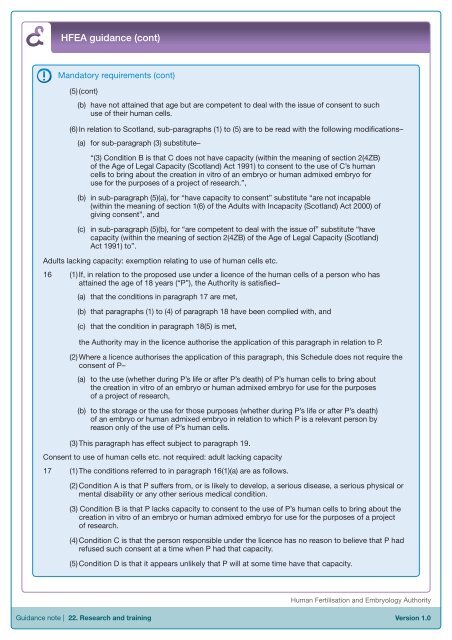Eighth Edition - R.3 - Human Fertilisation & Embryology Authority
Eighth Edition - R.3 - Human Fertilisation & Embryology Authority
Eighth Edition - R.3 - Human Fertilisation & Embryology Authority
You also want an ePaper? Increase the reach of your titles
YUMPU automatically turns print PDFs into web optimized ePapers that Google loves.
HFEA guidance (cont)<br />
Mandatory requirements (cont)<br />
(5) (cont)<br />
(b) have not attained that age but are competent to deal with the issue of consent to such<br />
use of their human cells.<br />
(6) In relation to Scotland, sub-paragraphs (1) to (5) are to be read with the following modifications–<br />
(a)<br />
for sub-paragraph (3) substitute–<br />
“(3) Condition B is that C does not have capacity (within the meaning of section 2(4ZB)<br />
of the Age of Legal Capacity (Scotland) Act 1991) to consent to the use of C’s human<br />
cells to bring about the creation in vitro of an embryo or human admixed embryo for<br />
use for the purposes of a project of research.”,<br />
(b) in sub-paragraph (5)(a), for “have capacity to consent” substitute “are not incapable<br />
(within the meaning of section 1(6) of the Adults with Incapacity (Scotland) Act 2000) of<br />
giving consent”, and<br />
(c)<br />
in sub-paragraph (5)(b), for “are competent to deal with the issue of” substitute “have<br />
capacity (within the meaning of section 2(4ZB) of the Age of Legal Capacity (Scotland)<br />
Act 1991) to”.<br />
Adults lacking capacity: exemption relating to use of human cells etc.<br />
16 (1) If, in relation to the proposed use under a licence of the human cells of a person who has<br />
attained the age of 18 years (“P”), the <strong>Authority</strong> is satisfied–<br />
(a)<br />
that the conditions in paragraph 17 are met,<br />
(b)<br />
(c)<br />
that paragraphs (1) to (4) of paragraph 18 have been complied with, and<br />
that the condition in paragraph 18(5) is met,<br />
the <strong>Authority</strong> may in the licence authorise the application of this paragraph in relation to P.<br />
(2) Where a licence authorises the application of this paragraph, this Schedule does not require the<br />
consent of P–<br />
(a) to the use (whether during P’s life or after P’s death) of P’s human cells to bring about<br />
the creation in vitro of an embryo or human admixed embryo for use for the purposes<br />
of a project of research,<br />
(b) to the storage or the use for those purposes (whether during P’s life or after P’s death)<br />
of an embryo or human admixed embryo in relation to which P is a relevant person by<br />
reason only of the use of P’s human cells.<br />
(3) This paragraph has effect subject to paragraph 19.<br />
Consent to use of human cells etc. not required: adult lacking capacity<br />
17 (1) The conditions referred to in paragraph 16(1)(a) are as follows.<br />
(2) Condition A is that P suffers from, or is likely to develop, a serious disease, a serious physical or<br />
mental disability or any other serious medical condition.<br />
(3) Condition B is that P lacks capacity to consent to the use of P’s human cells to bring about the<br />
creation in vitro of an embryo or human admixed embryo for use for the purposes of a project<br />
of research.<br />
(4) Condition C is that the person responsible under the licence has no reason to believe that P had<br />
refused such consent at a time when P had that capacity.<br />
(5) Condition D is that it appears unlikely that P will at some time have that capacity.<br />
<strong>Human</strong> <strong>Fertilisation</strong> and <strong>Embryology</strong> <strong>Authority</strong><br />
Guidance note | 22. Research and training<br />
Version 1.0

















